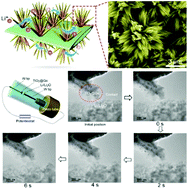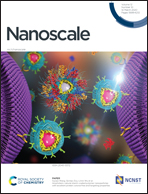An artificial sea urchin with hollow spines: improved mechanical and electrochemical stability in high-capacity Li–Ge batteries†
Abstract
Metallic germanium (Ge) as the anode can deliver a high specific capacity and high rate capability in lithium ion batteries. However, the large volume expansion largely restrains its further application. Herein, we constructed a three-dimensional sea urchin structure consisting of double layered Ge/TiO2 nanotubes as the spines via a ZnO template-removing method, which displays a capacity as high as 1060 mA h g−1 over 130 cycles. The robust, hollow oxide backbone serves as a strong support to accommodate the morphological change of Ge while the enhanced electron-transfer kinetics is attributed to the Ge content and the intimate contact between Ge and TiO2 during charging/discharging, which were confirmed using in situ transmission electronic microscopy observations and first-principles simulations. In addition, a high capacity retention of batteries using this hybrid composite as the anode was also achieved at low temperature.



 Please wait while we load your content...
Please wait while we load your content...